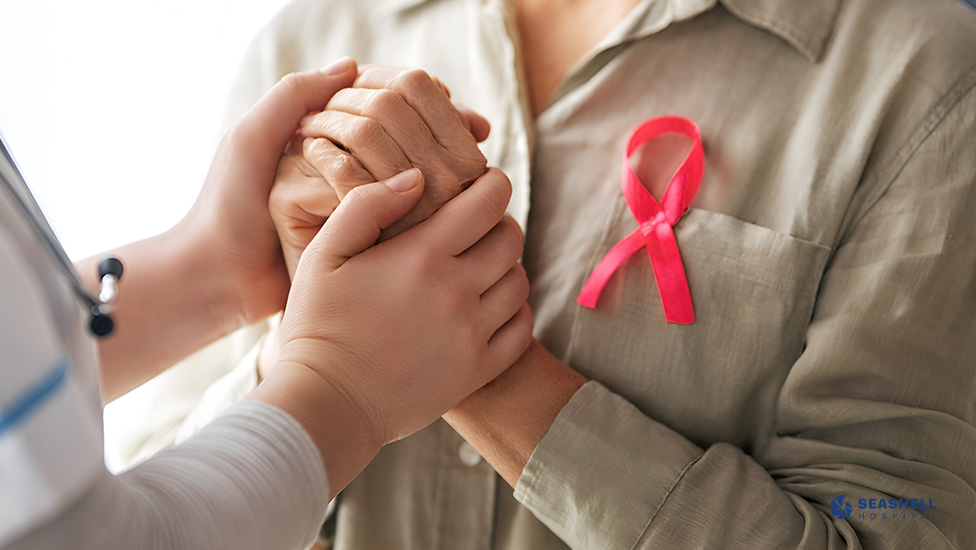 May 22, 2025
May 22, 2025
Breast Cancer
Breast cancer is the most common type of cancer among women, and awareness about all its aspects plays a major role in reducing risks and increasing the chances of recovery.
Raising awareness includes explaining the changes that may occur in the breast, the importance of regular and self-examinations, the types and stages of breast tumors, and how to prevent them. All of this will be addressed through 10 common questions about breast cancer:
1. Is regular breast self-examination enough to detect breast cancer?
Self-examination is not the most accurate or sufficient method to detect breast cancer, but it is a very important step in detecting any abnormal changes in the breast tissues early—such as lumps or changes in skin texture and nipple appearance.
However, regular medical check-ups and screenings (like mammography and ultrasound) are essential, as they are more accurate in detecting small changes that cannot be noticed by self-examination alone.
2. What is the best time to perform a breast self-exam?
The ideal time for a breast self-exam is 6 to 10 days after the end of the menstrual cycle, as the breasts are less affected by hormonal changes such as swelling or tenderness that may cause discomfort.
In the case of irregular or absent menstrual periods, it's recommended to choose a specific day each month to perform the self-exam regularly.
3. How to perform a breast self-exam?
To properly perform a breast self-exam, it is advised to examine in different positions to ensure accuracy:
In front of a mirror:
Observe any visible changes in the size or shape of the breasts while arms are at your sides, then again with arms raised above your head.
While lying down:
Lie on your back and place a pillow under your right shoulder to examine the right breast with your left hand.
Use the pads of your middle fingers to apply light, circular pressure in an up-and-down motion across all areas of the breast and underarm.
Repeat the same steps for the left breast using the right hand.
4. What breast changes should you watch for? Are all of them a concern?
There are many natural, non-worrisome breast changes caused by hormonal fluctuations during the menstrual cycle, pregnancy, breastfeeding, or aging. However, some changes require medical attention:
Lumps in the breast:
Normal:
-
Fibroadenomas: Benign, movable, painless, and round.
-
Cysts or fibrocystic changes that cause lumpiness and tenderness before periods.
Seek medical advice if:
-
The lump is hard, immobile, irregular in shape, or persists after menstruation.
Change in breast size or shape:
Normal:
Gradual changes may occur due to hormones, weight gain/loss.Seek medical advice if:
-
There's a sudden or asymmetric change in breast appearance.
Skin changes:
Normal:
Stretch marks or skin folds from weight changes or aging.Seek medical advice if:
-
There is redness, thickening, or dimpling like an orange peel.
Nipple discharge:
Normal:
-
Milky discharge during pregnancy or breastfeeding.
Seek medical advice if:
-
Bloody, clear, or persistent discharge from one breast not related to pregnancy or breastfeeding.
Nipple inversion:
Normal:
-
Some women naturally have inverted nipples.
Seek medical advice if:
-
New inversion occurs with redness, discharge, or associated lumps.
Breast pain:
Normal:
-
Common during menstruation or pregnancy.
Seek medical advice if:
-
Persistent, severe, and unrelated to the menstrual cycle.
5. What are the risk factors for developing breast cancer?
-
Family history of breast or ovarian cancer.
-
Early menstruation or late menopause.
-
Older age.
-
Radiation therapy before age 30.
-
Genetic mutations (e.g., BRCA1 and BRCA2).
6. What are the types of benign breast tumors?
Benign (non-cancerous) tumors do not spread and generally don’t turn into cancer but may need monitoring:
-
Fibroadenomas: Common in women aged 14–35, smooth, mobile lumps that may change with hormones.
-
Cysts: Fluid-filled sacs, more common before menopause.
-
Fibrocystic changes: Hormonal swelling and lumpiness.
-
Intraductal papillomas: Wart-like growths in milk ducts that may cause discharge.
-
Lipomas: Soft, slow-growing fatty lumps.
-
Breast abscess: Infection during breastfeeding causing painful, pus-filled lumps.
7. What are the types of breast cancer?
Invasive Breast Cancer:
-
Invasive Ductal Carcinoma (IDC): Most common; starts in milk ducts.
-
Invasive Lobular Carcinoma (ILC): Starts in milk-producing lobules.
Non-Invasive Breast Cancer:
-
Ductal Carcinoma in Situ (DCIS): Early stage, confined to milk ducts.
-
Lobular Carcinoma in Situ (LCIS): Not cancer, but a risk marker.
Subtypes:
-
Triple-negative breast cancer: Aggressive, lacks hormone receptors and HER2.
-
HER2-positive breast cancer: Fast-growing, HER2 protein overexpression.
-
Inflammatory breast cancer: Rare, fast-spreading, with redness and swelling.
-
Paget’s disease of the breast: Rare, affects nipple and surrounding area.
8. What are the characteristics of a cancerous breast lump?
-
Hard and immobile.
-
Irregular shape.
-
Usually painless in early stages.
-
May cause nipple retraction or skin changes.
-
Grows over time and may spread to the armpit or cause swelling.
Medical imaging (mammogram, ultrasound) and biopsy are essential for diagnosis.
9. What are the stages of breast cancer?
Staging helps determine treatment and prognosis:
Stage 0:
-
Confined to ducts/lobules; treated early to prevent spread.
Stage I:
-
Tumor ≤2 cm, may or may not involve nearby lymph nodes.
Stage II:
-
Tumor 2–5 cm, may spread to lymph nodes.
Stage III:
-
Locally advanced; >5 cm tumor, involves several lymph nodes or chest wall.
Stage IV:
-
Metastatic cancer; spread to organs like bones, liver, lungs, or brain.
10. If a family member has breast cancer, does it mean I will get it too?
About 70% of women diagnosed with breast cancer have no family history.
However, family history may increase risk in these cases:
-
Multiple cases on either side of the family.
-
First-degree relatives diagnosed before age 50.
-
Male relatives with breast cancer.
-
Cases of both breast and ovarian cancer.
Regular screening and genetic counseling are recommended.
How can I reduce my risk of breast cancer?
-
Healthy diet: Fruits, vegetables, whole grains, lean proteins.
-
Maintain healthy weight and exercise regularly.
-
Avoid smoking and secondhand smoke.
-
Regular screening: Mammograms and self-exams.
-
Know your family history and consult your doctor.
-
Avoid long-term hormone therapy (e.g., contraceptives or menopause medications).
Fear of discovering the disease should not stop you from getting screened. Early detection significantly increases recovery chances—up to 90% in early stages!
Screening should be seen as peace of mind, not a cause for concern.
To all breast cancer fighters—we wish you complete healing, ongoing strength, and unwavering hope in this journey.
Don’t hesitate to visit Sechel Hospital for regular check-ups and follow-ups with top breast surgery and OB/GYN consultants. Contact us now to schedule your appointment.
